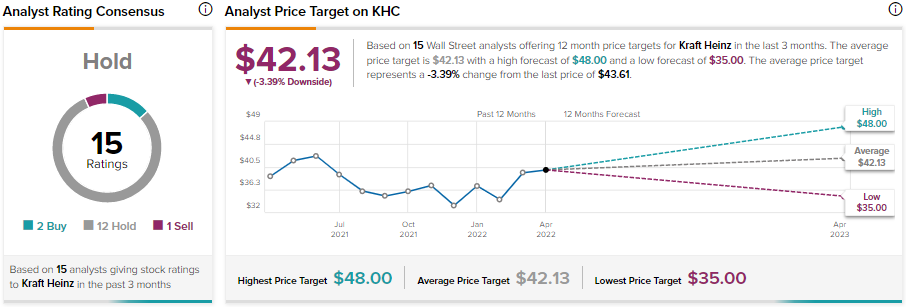Broad-based inflation is driving costs for food companies. It’s worth noting that prices of raw materials, including oil, wheat, corn, soybean, and others, have increased. Further, transportation and packaging costs also remain elevated.
The Russia/Ukraine conflict, supply constraints, and adverse weather conditions are to blame for rising costs.
To mitigate the impact of higher inflation, food companies rely on increasing their average selling price and focusing on productivity savings. However, will this inflation-driven pricing action be enough to offset the cost pressure? To find answers, let’s look at the recent performance, management commentary, and analysts’ take on some of the top food companies.
Conagra Brands (NYSE:CAG)
Conagra Brands announced its Q3 financials earlier this month. Highlighting the impact of higher-than-expected cost pressure, CAG’s CEO, Sean Connolly, stated that he expects this to continue in Q4 and lowered the full-year EPS guidance to $2.35 from $2.50.
Nevertheless, the company took pricing actions to counter the negative impact of higher costs. However, Connolly only expects to see the benefits of higher pricing in Q1 of FY23 due to the lag between inflation and the actions taken.
In response to CAG’s financial performance and guidance, Jefferies analyst Robert Dickerson stated, “Given the cost curve in dairy, proteins, and transportation, we’ve lowered our forecasts to account for incremental earnings power pressure. Much like the rest of food, CAG is now all about margin recovery; we simply don’t want to be overly optimistic given uncertainties around productivity potential and elasticities from here.”
While the analyst lowered his estimates, he maintained a Buy recommendation. Dickerson expects CAG’s profit margins to recover due to incremental pricing, diversified value-added products, and an improving supply chain.
Including Dickerson, two analysts recommend a Buy on CAG stock. Meanwhile, four analysts recommend Hold, leading to a Moderate Buy consensus rating. Further, the average Conagra Brands price target of $36.80 implies 2.5% upside potential to current levels.

Kraft Heinz (NASDAQ:KHC)
Kraft Heinz delivered impressive Q1 financial numbers. However, what stuck out was the 9% increase in pricing. By region, KHC increased prices by 9.3% in the U.S., 8% in Canada, and 8.2% in the international markets to mitigate the impact of rising input costs in the retail and food services channels.
Kraft Heinz is mulling additional pricing actions in the future, which would drive organic sales and help counter higher costs. During the Q1 conference call, KHC’s CFO, Andre Maciel, stated, “We are still catching up a little bit with the inflation that starts to rise at the end of last year, but on a year-over-year base, our price will be ahead of inflation.”
This, along with solid productivity savings, will support KHC’s margins in the coming quarters. Further, Maciel expects KHC’s margins to bounce back as costs stabilize.
BMO Capital analyst Kenneth Zaslow maintained a Hold recommendation on KHC stock post the Q1 results. However, Zaslow raised the price target to $46 from $41. Zaslow stated, “KHC raised its sales outlook but reiterated its EBITDA outlook of $5.8-6.0 billion despite increasing its expected inflation for its overall cost basket to mid-teens.”
Overall, KHC stock has received two Buy, 12 Hold, and one Sell recommendations for a Hold consensus rating. Further, the average Kraft Heinz price target of $42.13 implies 3.4% downside potential to current levels.

Kellogg (NYSE:K)
Kellogg will announce its Q1 financials on May 5. However, during the Q4 conference call, CFO Amit Banati stated that the company is witnessing higher input and packaging costs due to increased prices of ingredients (oil, wheat, and corn) and packaging materials (cans and cartons).
Deutsche Bank analyst Stephen Powers downgraded Kellogg stock to a Hold citing new headwinds, including worsening inflation and the Russia/Ukraine conflict.
Powers is cautious about the “carry-over impacts from the worker strike across K’s US cereal plants in 4Q21, worsening inflation/supply chain disruptions year-to-date, negative Russia/Ukraine impacts, more adverse FX, and a potential weakening of consumer demand/confidence to the detriment of K’s volume trends and market share.”
Along with Powers, most Wall Street analysts remain sidelined on Kellogg stock. It has received one Buy, eight Hold, and two Sell recommendations for a Hold consensus rating. Further, the average Kraft Heinz price target of $67.45 implies 3% downside potential to current levels.

Bottom Line
These food giants are expected to chug along nicely as inflation-driven pricing action and productivity savings could continue to cushion their margins. However, the upside remains capped as rising grocery bills and macro concerns add uncertainty.
Discover new investment ideas with data you can trust.
Read full Disclaimer & Disclosure









